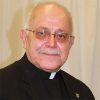One of the first things missioners experience when we go overseas is that people have a different understanding of time than we do. Back in the day before modernization, “Korean time” meant anything from 15 minutes to an hour after an appointment. In Latin America mañana can mean tomorrow or never. On the other hand, Germans are frustrated when Americans arrive even five minutes late.
Once, in 1986, I was traveling in Egypt with a Maryknoll photographer. We hopped a cab in Cairo for an appointment in suburban Heliopolis. Stuck in a perpetual traffic jam where camels and donkeys vie with cars, buses and trucks, we asked the driver, “How long will this take?”
“Just a little while,” he replied.
But, as we inched along, I began to worry. What does “a little while” mean to a people who literally invented the concept of eternity?
The mystery and miracle of Christmas is God didn’t just take on our human nature but entered fully into time, transforming our chronos (routine, chronological time) into God’s kairos (the fullness of time). The eternal became finite, the almighty became small and vulnerable. The Creator of the universe deigned to be born in a small galaxy, in a minuscule solar system, on an insignificant planet, in a remote corner of the empire, to an oppressed people, in a little village.
Centuries before, the prophet Micah foretold Bethlehem was by no means least among the tribes of Judah, for from it would come one to shepherd Israel—the promised and long-awaited Messiah!
St. Paul writes to both Galatians and Ephesians that Christ came “in the fullness of time.” The prophesies, the expectations, the people were all in place, whether they realized it or not. In other words, the Messiah finally came, not when the world was ready, not when it was holy or perfect, but rather when the time was right. Jesus announced the chronos of the kingdom had come: at the right time, in the right place, through the right events, in the right person.
So wonderful and amazing were the birth, life, teachings, death and resurrection of Jesus that Western civilization divides history between B.C. (before Christ) and A.D. (Anno Domini — Year of the Lord), consecrating humanity, history and time in the process.
When early Christians wanted to celebrate the birth of Christ, since the exact date is not mentioned in the Gospels, the Church chose what was then the darkest day of the year (the winter solstice in the Northern Hemisphere) to emphasize that Christ, our true Light, came when humankind needed him most.
Catholicism encourages us to ask what God is calling us to do with this precious, irreplaceable gift of time. St. Paul says in 2 Corinthians 6:2, “Behold, now is an acceptable time; behold, now is the day of salvation.” Christ continues to transform our chronos into kairos. Christ calls us each year to begin anew. Our faith responds: “It’s about time.”
This 17th century painting by Dutch artist Gerard van Honthorst depicts the adoration of the Christ Child, who came “in the fullness of time.” (CNS/Uffizi Gallery/Florence/Italy)

